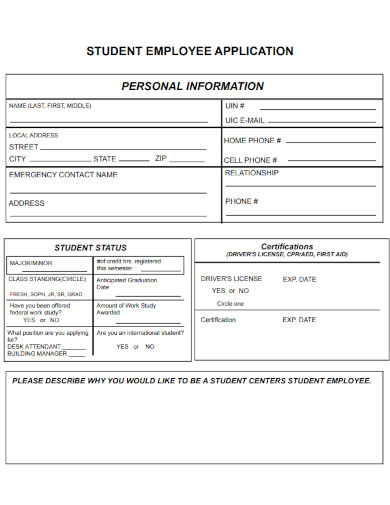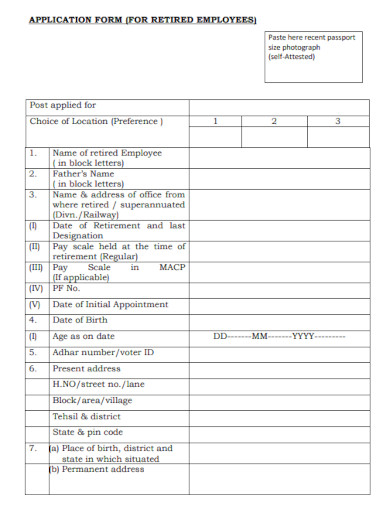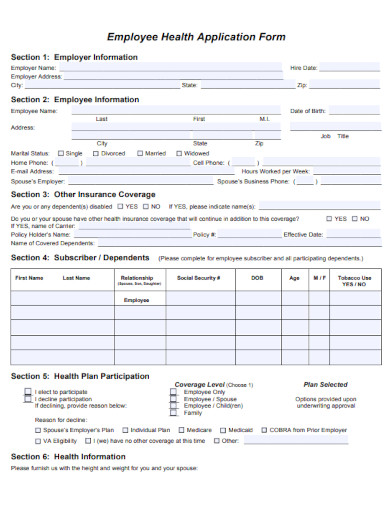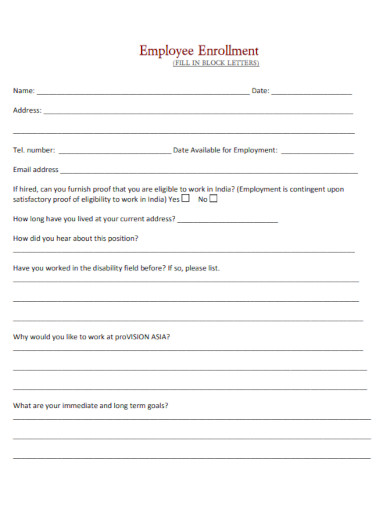25+ Sample Employee Application
-

Employee Application
download now -

Company Employee Application
download now -

General Employee Application
download now -

Employee Application for Group Coverage
download now -

Probationary Employee Application
download now -

Job Employee Application
download now -

Employee Application Form
download now -

Printable Employee Application
download now -

Organisation Employee Application
download now -

Certified Employee Application
download now -

Employee Application Sample Form
download now -

Fillable Employee Application
download now -

Employee Employment Application
download now -

Small Group Employee Application
download now -

Employee Application Format
download now -

Employee Application Form Format
download now -

Downloadable Employee Application
download now -

Bank Employee Application
download now -

Employee Application for Career Break
download now -

Student Employee Application
download now -

Retired Employee Application
download now -

Employee Application for Employment
download now -

Employee Health Application Form
download now -

Employee Enrollment Application
download now -

Employee Joining Application
download now -

Health Insurance Employee Application
download now
What Is an Employee Application?
An employment application is a formal business document containing questions regarded as relevant by employers. It determines the most qualified candidate for a specific position within the organization. Employer and employee forms are typically utilized for a variety of purposes. Most commonly, they are used to establish a contract for services between parties. Either party may use the forms to request, submit payment information, and fulfill other obligations.
Benefits of Being Employed
For decades, working full-time was regarded as the pinnacle of one’s career — a sure sign that one had earned a secure position with a reputable employer, deserved a protected salary and was skilled enough to warrant long-term investment. Start with one of the most essential questions: how do I know if a full-time contract is not the best option? Regardless of where you are in your career, particularly if you’re starting, self-analysis is essential. As we move into a post-pandemic environment and as more and more individuals leave their positions and seek new career paths, this issue is becoming increasingly urgent. This section will assist you in determining the type of employment contract and working lifestyle that will best suit your future.
Tips for Completing a Job Application
Often, submitting a job application is your first contact with a potential employer; therefore, it is essential to make a good appearance. Knowing what to compose and what the hiring manager is searching for will assist you in submitting a successful application. There are several essential measures you must take when submitting a job application.
1. Review the Employment Application
Reading the job application may seem like an apparent phase, but many individuals need to perform it. Even if you scanned the job description before applying, rereading it is still a good idea to ensure you notice all the essential details. Typically, employers receive hundreds of applications for each available position. One of the most common ways they will use to check the applicant pool is to eradicate those they believe still need to read the job description and requirements. Also, many employers utilize applicant monitoring systems (ATS). This is an automatic system that can be fine-tuned to reject applications that are incomplete or lack the appropriate keywords. Even if you cannot precisely anticipate what the ATS is searching for, you can still advance your application by including the correct information.
2. Utilize a Business Name and Email Address
Professional employment applications require professional email addresses. Some employers may disqualify a candidate for having an unprofessional email address, even if the remainder of their resume demonstrates their qualifications. You can use a free email service to create a professional email account to establish a skilled email address. Utilize your first and last name, or a variant, on all of your employment applications. Never is it a lousy notion to separate professional and personal communication. Your job search may be an ideal time to network.
3. Follow the Guidelines
Sometimes a field requires an entire paragraph, a few sentences, or simply “yes” or “no.” There are also fields where you must devote time to answering detailed inquiries. Regardless of the specific requirements of the queries, ensure that you provide accurate responses. Read the query multiple times to ensure comprehension, and take time to formulate a comprehensive response. Some employers pose various questions, including hypothetical, behavioral, and character-based questions. To increase your likelihood of success, you must respond to these queries effectively and precisely. Not all applications will contain lengthy response inquiries, but it never hurts to follow the instructions strictly. Carefully completing the form demonstrates to the employer that you are a qualified candidate invested in the recruiting process.
4. Check Your Responses for Errors
Spelling and grammar errors demonstrate to a potential employer that you should have taken the time to proofread or lack written communication skills. Most jobs require basic communication skills; therefore, not making an effort to submit a resume free of spelling errors, using the proper pronouns, and adhering to other grammar rules can reduce your chances of being hired. Utilize caution when completing the application. If you are unsure how well you have corrected errors, you should have someone else review your application and make corrections if they discover any. An error-free application has a much greater chance of being at least reviewed than one filled with readily avoidable errors.
How to Find a Job Quickly
You may need to locate a job quickly in your professional life. Finding a job can be difficult, but with effort, you can find one that meets your requirements. Understanding how to optimize your job search can expedite the procedure. If you’re still interested, here are some additional steps to take.
1. Find Employment That Matches Your Credentials
Create a list of your work history, education, and talents. Then, seek out a position for which you are qualified. You should register for jobs in your desired field or industry, but it may be necessary to broaden your search. Consider searching for positions you may have yet to apply for but meet your requirements initially. For instance, if you are a sales representative, you could look for business development or marketing positions. Your sales abilities are likely transferable to these positions. You can also search for jobs in a company you want to work for, then plan a lateral career move after at least a year of service. When applying for employment, make the process continuous. Even if a company contacts you for a phone screen or interview, you should continue using it if you don’t get the job or the offer differs from what you anticipated. In some instances, you may be presented with multiple job offers.
2. Optimize Your Resume and Cover Letter
Recruiters may only consume a few seconds reviewing a resume, so you must grab their attention immediately by optimizing each cover letter and sample resume you submit. Your resume and cover letter should be brief, simple to read, and memorable to the recruiting manager. Create your cover letter and resume or compose a new one for every position you apply for. Explain in your cover letter why you want to work for the company and provide a summary of your qualifications. You should also explain how you can contribute to the company’s success and how you differ from other applicants. In your resume, emphasize any relevant experience and talents that you possess. To provide a clear and concise overview of your background, restrict your employment history to the past five to seven years or three positions. You can also include information about volunteer work, continuing education courses, and other completed endeavors. Even if you have not developed your skills conventionally, recruiters are interested in what you have learned. For instance, if you were an adolescent babysitter, you likely gained transferable skills such as communication, organization, time management, and multitasking.
3. Request Assistance From Your Network
Some people find it difficult to ask for assistance, but it can be an effective method to find a job quickly. Communicate with other industry professionals at industry events via email and social media. Connect with former coworkers and ask your friends, acquaintances, and family members to let you know if they hear of a suitable position. If you know someone who works for an organization that interests you, ask them for application advice. You may have a greater chance of receiving an interview if you know the specific skills, experiences, and personality traits a company seeks. Additionally, you can request a referral or a recommendation. Also, reaching out to your college’s alumni association, professional organizations, and former coworkers can be beneficial. Talking to the correct individuals can expedite your job search and provide more information about available opportunities.
4. Consider an Interim Position
A contract or temporary position can help you bridge an employment hiatus while you search for permanent employment. Since businesses frequently require temporary workers immediately, the recruiting process is quick. In addition, if an employer in your field appreciates the temporary or contract work you perform, they may promote you to a permanent position. This position will assist you in managing your expenses until you locate a job you enjoy.
FAQs
What is the total rewards strategy?
A total rewards strategy is a system implemented by an organization that provides monetary, non-monetary, and developmental rewards to employees who achieve particular business objectives. The design combines compensation and benefits with opportunities for personal development in a highly-motivated work environment.
What is an employee reward plan?
By encouraging them with gifts, praise, and monetary and non-monetary incentives, employee reward systems help companies recognize their employees’ efforts and results. This type of employee recognition structure permits employers and managers to reward their teams in the manner that motivates each member the most.
What is effective reward management?
Reward management is a strategic approach to motivating your personnel to enhance performance, engagement, and morale: It rewards employees based on the company’s values and what they are willing or able to fund. It rewards employees for the value they generate and contributes to the well-being of employees.
An employee application form is a document used to collect information from prospective employees during the hiring procedure. Use this free Employment Application Form template to gather the necessary information, whether you’re employing a receptionist or a new executive. Due to its uncomplicated design, ]this online employment application form can be embedded in seconds or shared via a link. It is user-friendly and appears excellent on all devices.
